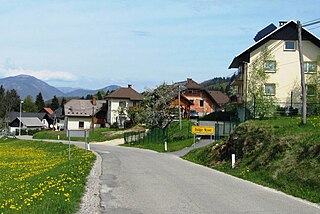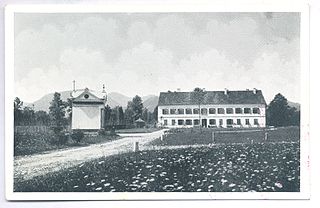| Zgornje Grušovlje | |
|---|---|
| Coordinates: 46°16′23.51″N15°6′30.97″E / 46.2731972°N 15.1086028°E Coordinates: 46°16′23.51″N15°6′30.97″E / 46.2731972°N 15.1086028°E | |
| Country | |
| Traditional region | Styria |
| Statistical region | Savinja |
| Municipality | Žalec |
| Area | |
| • Total | 1.39 km2 (0.54 sq mi) |
| Elevation | 279.6 m (917.3 ft) |
| Population (2002) | |
| • Total | 181 |
| [1] | |
Zgornje Grušovlje (pronounced [ˈzɡoːɾnjɛ ɡɾuˈʃoːu̯ljɛ] ) is a settlement in the Municipality of Žalec in east-central Slovenia. It lies in the lower Savinja Valley northwest of Šempeter v Savinjski Dolini. Traditionally the area was part of Styria. The municipality is now included in the Savinja Statistical Region. [2]

A municipality is usually a single urban administrative division having corporate status and powers of self-government or jurisdiction as granted by national and regional laws to which it is subordinate. It is to be distinguished (usually) from the county, which may encompass rural territory or numerous small communities such as towns, villages and hamlets.

Žalec is a town in central Slovenia. It is the seat of the Municipality of Žalec. It lies in the valley of the lower course of the Savinja River west of Celje. The primary economic activity of the region is growing hops, which is reflected by the city's coat-of-arms. The area was part of the traditional region of Styria. The municipality is now included in the Savinja Statistical Region.

Slovenia, officially the Republic of Slovenia, is a sovereign state located in southern Central Europe at a crossroads of important European cultural and trade routes. It is bordered by Italy to the west, Austria to the north, Hungary to the northeast, Croatia to the southeast, and the Adriatic Sea to the southwest. It covers 20,273 square kilometers (7,827 sq mi) and has a population of 2.07 million. One of the successor states of the former Yugoslavia, Slovenia is a parliamentary republic and a member of the United Nations, of the European Union, and of NATO. The capital and largest city is Ljubljana.
The hamlet of Dolge Njive (Slovene : Dolge njive) in the settlement is the site of a Roman Villa rustica. [3]

Slovene or Slovenian belongs to the group of South Slavic languages. It is spoken by approximately 2.5 million speakers worldwide, the majority of whom live in Slovenia. It is the first language of about 2.1 million Slovenian people and is one of the 24 official and working languages of the European Union.

In historiography, ancient Rome is Roman civilization from the founding of the city of Rome in the 8th century BC to the collapse of the Western Roman Empire in the 5th century AD, encompassing the Roman Kingdom, Roman Republic and Roman Empire until the fall of the western empire. The civilization began as an Italic settlement in the Italian peninsula, dating from the 8th century BC, that grew into the city of Rome and which subsequently gave its name to the empire over which it ruled and to the widespread civilisation the empire developed. The Roman empire expanded to become one of the largest empires in the ancient world, though still ruled from the city, with an estimated 50 to 90 million inhabitants and covering 5.0 million square kilometres at its height in AD 117.

Villa rustica was the term used by the ancient Romans to denote a villa set in the open countryside, often as the hub of a large agricultural estate (latifundium). The adjective rusticum was used to distinguish it from an urban or resort villa. The villa rustica would thus serve both as a residence of the landowner and his family and also as a farm management centre. It would often comprise separate buildings to accommodate farm labourers and sheds and barns for animals and crops. In modern British archaeology, a villa rustica is commonly referred to simply as a "Roman villa".




